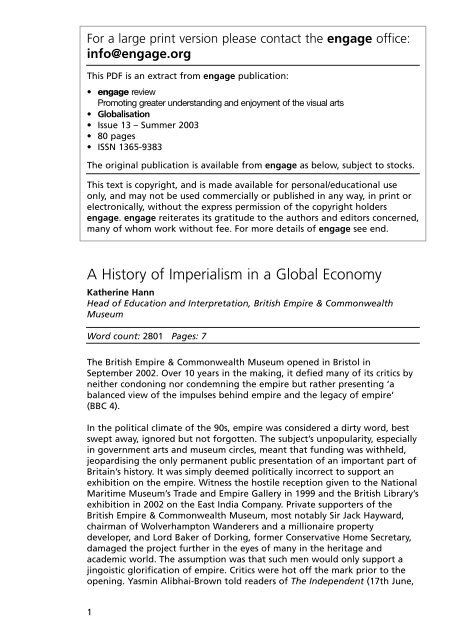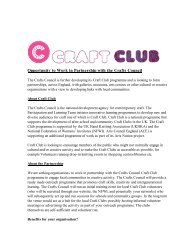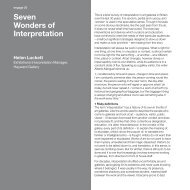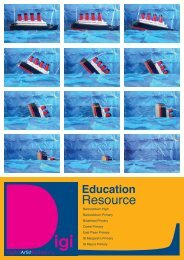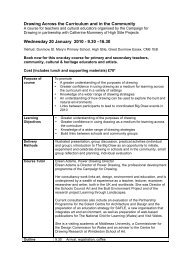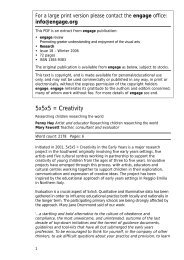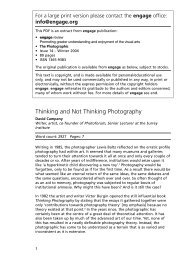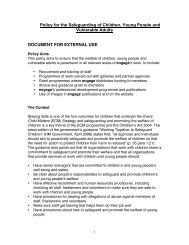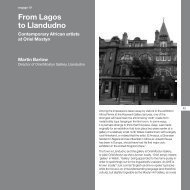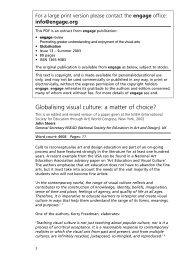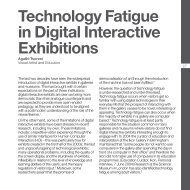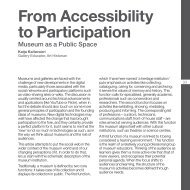13. Katherine Hann - Engage
13. Katherine Hann - Engage
13. Katherine Hann - Engage
Create successful ePaper yourself
Turn your PDF publications into a flip-book with our unique Google optimized e-Paper software.
For a large print version please contact the engage office:<br />
info@engage.org<br />
This PDF is an extract from engage publication:<br />
• engage review<br />
Promoting greater understanding and enjoyment of the visual arts<br />
• Globalisation<br />
• Issue 13 – Summer 2003<br />
• 80 pages<br />
• ISSN 1365-9383<br />
The original publication is available from engage as below, subject to stocks.<br />
This text is copyright, and is made available for personal/educational use<br />
only, and may not be used commercially or published in any way, in print or<br />
electronically, without the express permission of the copyright holders<br />
engage. engage reiterates its gratitude to the authors and editors concerned,<br />
many of whom work without fee. For more details of engage see end.<br />
A History of Imperialism in a Global Economy<br />
<strong>Katherine</strong> <strong>Hann</strong><br />
Head of Education and Interpretation, British Empire & Commonwealth<br />
Museum<br />
Word count: 2801 Pages: 7<br />
The British Empire & Commonwealth Museum opened in Bristol in<br />
September 2002. Over 10 years in the making, it defied many of its critics by<br />
neither condoning nor condemning the empire but rather presenting ‘a<br />
balanced view of the impulses behind empire and the legacy of empire’<br />
(BBC 4).<br />
In the political climate of the 90s, empire was considered a dirty word, best<br />
swept away, ignored but not forgotten. The subject’s unpopularity, especially<br />
in government arts and museum circles, meant that funding was withheld,<br />
jeopardising the only permanent public presentation of an important part of<br />
Britain’s history. It was simply deemed politically incorrect to support an<br />
exhibition on the empire. Witness the hostile reception given to the National<br />
Maritime Museum’s Trade and Empire Gallery in 1999 and the British Library’s<br />
exhibition in 2002 on the East India Company. Private supporters of the<br />
British Empire & Commonwealth Museum, most notably Sir Jack Hayward,<br />
chairman of Wolverhampton Wanderers and a millionaire property<br />
developer, and Lord Baker of Dorking, former Conservative Home Secretary,<br />
damaged the project further in the eyes of many in the heritage and<br />
academic world. The assumption was that such men would only support a<br />
jingoistic glorification of empire. Critics were hot off the mark prior to the<br />
opening. Yasmin Alibhai-Brown told readers of The Independent (17th June,<br />
1
2002) to beware of its ‘bogus history’; historian Michael Fry branded its<br />
approach towards the Scots as ‘very evil’ (The Sunday Times [Scotland], 23rd<br />
June, 2002).<br />
But 500 years of history cannot be swept away. At its height the British<br />
empire controlled over a quarter of the world. A need to understand empire<br />
and put it firmly in the public arena has been evidenced with recent<br />
television coverage including Channel 4’s extremely well received series<br />
‘Empire’.<br />
Setting up the museum<br />
Museum staff working with a wide range of people - academics, advisers,<br />
researchers, and assisted by a Bristol-based focus group - established a<br />
permanent exhibition in under a year. The focus group comprised<br />
a small number of mainly Black Afro-Caribbean Bristolians. Advice given by<br />
Bristol City Museum and Art Gallery after their exhibition, ‘Bristol and<br />
Transatlantic Slave Trade’ highlighted the importance of involving local<br />
people, not just national figures. The group included Eddson Burton from<br />
the Afro-Caribbean organisation Kuumba, the 87 year-old Jamaican historian<br />
Dick Hart, the well-known activist Ben Bousquet, and Kam Kelly, a young<br />
Australian DJ.<br />
The group discussed a range of issues, including the vexed question of<br />
displaying slavery in a static exhibition. One of the strongest feelings to come<br />
from the group was the need to portray the cultures of indigenous<br />
populations prior to colonisation, and then continue to represent their views<br />
of colonisation throughout. As a result of this, our exhibits on slavery start<br />
with the richness and wealth of African cultures before the establishment of<br />
the slave trade recognising that black cultures have their own history and do<br />
not want to be portrayed simply as victims within the world order. Different<br />
voices are represented throughout the exhibitions through the use of<br />
powerful first person oral testimonies and quotation panels. This allows<br />
contradictions and differing perspectives to emerge.<br />
Ongoing consultation involves working with a number of different agencies.<br />
This process has been expanded to take greater account of the views of<br />
young people, particularly those who feel disconnected from their own<br />
personal history, and as a consequence, disaffected from the formal<br />
education system. A comment from one visitor, Nick L, age 12, was: ‘Thanks<br />
for showing me a part of history my school has completely ignored.’<br />
Academically, Professor P.J. Marshall, editor of The Cambridge Illustrated<br />
History of the British Empire, lent his credibility to the project by personally<br />
checking every piece of text. Further funding was secured from a number of<br />
educational trusts and foundations including Linbury, Garfield Weston,<br />
Pilgrim, Calouste Gulbenkian, Rhodes and the Clore Duffield Foundation.<br />
It is not a museum dedicated to the story of the role of the British in the<br />
empire in the same way as Australia, Canada, Hong Kong, New Zealand, and<br />
Singapore have national museums addressing their colonial experience. The<br />
museum represents different perspectives and opinions and does not speak<br />
2
for white Britons only. English, Welsh, Irish and Scots appear alongside the<br />
Africans, Asians, and indigenous peoples who comprised the bulk of the<br />
empire’s population. The objects, images, and quotations on display<br />
represent the experiences and judgements of people who lived under and<br />
rebelled against British rule, as well as those who extended and enforced it.<br />
African cowrie shell headdresses, Asante gold ornaments and carved ivory<br />
are displayed alongside handcuffs, leg irons and slave whips. The use of first<br />
person quotations throughout the exhibition is a particularly powerful way<br />
of communicating different points of view:<br />
‘It is not true that we are against civilization, that our aims are to take our<br />
people back to ancient times. Our fighting is for the return of our stolen<br />
land and freedom...The Europeans have occupied our best land and have<br />
also reduced us to slavery...Imagine the thousands of Africans who lost their<br />
lives during the two World Wars. What did they die for, and did we benefit<br />
from these Wars? Our reward was slavery.’ Dedan Kimathi, Kenyan freedom<br />
fighter, 1954<br />
The duality of sentiment so often expressed about the relationship of<br />
different countries to the Commonwealth is boldly stated by Amitav Ghosh<br />
with reference to the Commonwealth Writers’ Prize 2001,<br />
‘As a grouping of nations collected from the remains of the British Empire,<br />
the Commonwealth serves as an umbrella forum in global politics. As a<br />
literary or cultural grouping however, it seems to me that “the<br />
Commonwealth” can only be a misnomer so long as it excludes the many<br />
languages that sustain the cultural and literary lives of these countries.’<br />
As the aim of the museum is to present neither a celebratory nor a<br />
condemning picture of the empire, the overwhelmingly positive press<br />
reviews since it opened suggest some measure of success. It has been<br />
described in The Guardian as ‘a valuable and accessible narrative,<br />
imaginatively and carefully told’ (2 November, 2002) and on Radio 4 as ‘a<br />
brilliant new museum’. Linda Colley suggests in The Sunday Telegraph (27th<br />
October, 2002) that there are valuable lessons to be learnt from exploring<br />
such a history:<br />
‘We may be in a post-colonial world but we are not yet in a post-imperial<br />
world. This museum could illuminate how empires work: how a small polity<br />
like Britain was able through its economy, navy and advanced<br />
communications to sprawl over vast stretches of the globe. America is doing<br />
the same thing today.’<br />
The museum is situated in Brunel’s original Great Western Railway Station at<br />
Temple Meads in Bristol. It is a felicitous choice; from Cabot and slavery to<br />
West African trade and Afro-Caribbean immigration, Bristol had many ties to<br />
the empire. Moreover, what building could better symbolise Britain’s<br />
territorial expansion in the industrial age than the world’s first purpose-built<br />
railway terminus?<br />
3
Content and interpretation<br />
Inevitably, with 500 years to cover, even well-known episodes in the history<br />
of empire have had to be omitted or skimmed over. The museum does not<br />
overload visitors with dates and names, opting instead for thematic galleries<br />
arranged in chronological order. The galleries begin with Bristol’s maritime<br />
endeavours in the late fifteenth century and continue through to the present<br />
day. Three main phases are identified: the building of an empire (1480 -<br />
1800); the empire at its height in the Victorian period (1800 - 1900); and the<br />
end of empire and the move from colonialism to Commonwealth (1900 to<br />
today). Gallery themes include monopoly trading companies, enslaved<br />
labour, humanitarian ideals, and post-colonial immigration<br />
to Britain.<br />
The museum avoids duplicating existing displays. There is no point in<br />
retelling the history of the Second World War, for instance, when the<br />
Imperial War Museum and the National Army Museum already do it very<br />
well. Instead the museum attempts to show how the war affected<br />
perceptions of the empire and speeded up its demise. Similarly, it could not<br />
hope to represent the glories of the Benin empire in the way that the British<br />
Museum or the Pitt Rivers Museum do, but it can explain the controversial<br />
way in which Benin’s treasures came to Britain. The legacy of empire in terms<br />
of cultural exchange - food, music, dance and festivals - and its impact on our<br />
lives today is given greater prominence than in many other exhibitions.<br />
The museum uses a number of interpretative devices to make the subject<br />
come alive for non-specialists. There is an unusual audio-visual introduction<br />
that, because of its style, can afford to be controversial. Shot as a series of<br />
short takes direct to camera it shows differing views of empire from people<br />
of varying ages and backgrounds. An elderly black male states that the<br />
British empire was ‘imperialism at its worst. It was about greed power and<br />
white supremacy.’ This is immediately followed by younger Asian voice<br />
seemingly contradicting the previous statement by suggesting<br />
‘It was simple economics. People just wanted to make money. Who doesn’t?’<br />
There are first person accounts of both living in, and emigrating from,<br />
countries of the Commonwealth.<br />
There are displays of archive film footage, oral history stations, original and<br />
facsimile documents, hands-on interactives, computer games, a series of<br />
humorous questions and answers, personal quotations and narratives,<br />
dressing up areas, and of course the objects themselves. The early history of<br />
the empire is rich in objects, such as Chinese porcelain, Indian fabrics, and<br />
ethnographic items from the Americas and Pacific. As the Museum’s<br />
collections were not strong in these areas it was fortunate that loans were<br />
secured from a number of institutions, including: Anti-Slavery International,<br />
the British Museum, Dundee City Council, the Horniman Museum, Hull<br />
Maritime Museum, the National Army Museum, the National Maritime<br />
Museum, and the Science Museum.<br />
The complexity of the subject matter and the fact that some information is<br />
simply too abstract to display means that the intention behind the displays is<br />
to spark the visitor’s interest in a topic and then point the way towards more<br />
4
detailed resources. All visitors can consult the Museum’s printed book,<br />
manuscript, and oral history collections in a library and archive visible from<br />
the exhibition through a glass wall.<br />
Contributing to the global debate<br />
Can an organisation such as this contribute to a global debate? Unlike many<br />
museums with a particular local or a national focus, the British Empire &<br />
Commonwealth Museum has a genuine international angle. It covers, from a<br />
historical perspective, many of the issues that are current today. Few Britons,<br />
for example, realise that Palestine is a former British colony gained after the<br />
First World War.<br />
The museum also explores some of the factors that have speeded up the<br />
process of globalisation, particularly communications. The world seems to be<br />
continually getting smaller, and a large part of what makes living in<br />
a global culture and economy possible is improvements in communication<br />
systems. Computer and internet systems make for almost instantaneous<br />
communications. Improved transport means you can reach virtually anywhere<br />
on the planet within not much more than a day. The rate of change may be<br />
faster now than ever before, but the process has been underway for<br />
centuries. In 1770, it took seven months to get a message from London to<br />
Calcutta. In 1840, with the change from sailing ships to steam and the<br />
opening of the Suez Canal, this journey time was reduced to 1 month. With<br />
the introduction of the telegraph by 1870, it was cut further to 6 hours, and<br />
satellite communications today mean it is can take less than minute. In fact,<br />
the exponential growth in the service industry and the new ‘call centre<br />
culture’ means that it pays some companies to staff centres not just in<br />
Scotland but also in India for sales in the UK.<br />
Culturally, the downside of globalisation is that no part of the world remains<br />
isolated from Western influences - witness the McDonald golden arches<br />
springing up everywhere from Moscow to Taiwan. The heritage sector’s<br />
business is premised on celebrating difference, as regular museum visitors<br />
recognise. Does globalisation mean increasing sameness? For the first year<br />
ever, McDonalds has had a financial downturn - a striking turnaround for a<br />
company that has long been synonymous with Pax Americana. Perhaps this is<br />
beginning to signal more general public disaffection with a new world order.<br />
Visitor surveys<br />
At the end of the museum, a section looks at the make-up of the current<br />
Commonwealth, and visitors have the option of completing a computerised<br />
survey. Although obviously a self-selected group, the results make fascinating<br />
reading and help to paint a picture of present day perceptions on issues<br />
related to empire and the Commonwealth. Public awareness of the role of<br />
the Commonwealth is woefully lacking. It exists as a significant non-political<br />
system for sharing education and technology, promoting international<br />
understanding and world peace across 54 independent states. It consists of<br />
1.7 billion people - that is 30% of the world’s population - and over a<br />
quarter of its land surface. In response to the question ‘Where does Britain’s<br />
future lie?’, 55% of respondents said with Europe, only 19% said with the<br />
Commonwealth and 13% said with America. (n = 1500)<br />
5
Cultural tourism<br />
A curator at the British Empire & Commonwealth Museum at a lighter<br />
moment during the opening of the permanent galleries dismissed a large<br />
part of the collection as ‘tourist tat’. Much of the material culture in<br />
museums is, of course, the result of adventurous souvenir hunters - some of<br />
which has a significance on the scale of the Elgin marbles but is accompanied<br />
by significant ethical questions.<br />
Tables began to turn in the tourism stakes as early as the 1700s with Cook’s<br />
journeys to the Pacific. Cook and his crew were fascinated by the cultures<br />
they encountered there. The indigenous populations quickly picked up on<br />
this and began purposefully creating souvenirs adapted to Western taste,<br />
such as weapons, tools and the ever-popular cannibal forks.<br />
But of course questions of global tourism have a very serious side and the<br />
museum has a section dedicated to the question of ‘Development dilemmas’.<br />
As poorer colonies struggled to develop, and were particularly hard-hit in<br />
the great depression of the 1930s, Britain introduced a system of ‘imperial<br />
preference’ making countries in the empire trade with each other. This<br />
generated heavy dependency on single crop cultures, such as bananas in the<br />
case of Jamaica, that was only loosened when Britain entered the European<br />
Common Market in 1973. But was this worse than the supposed<br />
diversification that followed? In 1965, the Caribbean island of St Lucia<br />
depended on banana exports. By 2000, tourism was its biggest industry,<br />
earning over US$ 250 million. But tourism comes at a cost - damaging the<br />
environment, for example, in spite of moves towards eco-tourism.<br />
International tour companies profit more than local traders, particularly from<br />
all-inclusive packages. The American or European tourists can seem like a<br />
new wave of colonisers, and particularly in the Caribbean there is a feeling<br />
that rich white people are still running black people’s lives.<br />
Cultural diversity<br />
With such a vast story to tell there is little space for celebrating the richness<br />
of multi-racial Britain today - over 300 languages and at least 14 faiths exist<br />
among a population of 60 million. This is being redressed through the events<br />
programmes on offer. Commonwealth FM 87.7 is a community radio station<br />
that broadcast live in October 2002 in Chinese, Somali, Arabic, Punjabi,<br />
Bengali and English. It had project funding from the Heritage Lottery Fund<br />
and was highly commended in the education category of the inaugural<br />
Museums & Heritage Show Awards for Excellence 2003. Commonwealth FM<br />
will broadcast live again in 2003.<br />
A significant project is currently being considered by the Regional Arts Board<br />
for a series of artists-in-residence to work cross-culturally with communities<br />
looking at similarities and differences in festivals as part of this year’s<br />
‘Decibel’ programme to promote cultural diversity and raise the profile of<br />
Black and Asian artists.<br />
The museum confronts controversial issues such as racism, economic<br />
exploitation, and cultural imperialism. It canvasses a wide range of<br />
experiences of imperial rule and divergent opinions about it. The<br />
6
perseverance of supporters and staff means future generations no longer risk<br />
finding big gaps in the historical record. Britons of all races have to know<br />
this history if they are to make sense of their society and move confidently<br />
into the future. The heritage sector has gained a museum with designated<br />
national status which is testimony to the significance of its collections and its<br />
contribution to such an important part of the historical record. The recent<br />
acquisition of the material culture and literature collection of the<br />
Commonwealth Institute has further cemented this pivotal role. The British<br />
Empire & Commonwealth Museum is in a position to encourage reflection on<br />
the past and thus to contribute to ongoing contemporary debates in a global<br />
economy.<br />
The British Empire & Commonwealth Museum,<br />
Station Approach, Temple Meads, Bristol, BS1 6QH<br />
Telephone 0117 925 4980<br />
staff@empiremuseum.co.uk<br />
www.empiremuseum.co.uk<br />
––––––––––––––––––––––––––––––––––––––––––––––––––––––––––––––––––––––––<br />
<strong>Katherine</strong> <strong>Hann</strong> works part-time as Head of Education & Interpretation at the<br />
British Empire & Commonwealth Museum, Bristol. She also acts as a consultant<br />
with 16 years of education experience behind her, 10 of which is in museums<br />
and science centres. She has taught at both Primary and Higher Education level<br />
with a specialism in science education. She was Education Manager at the<br />
Science Museum, set up the innovative Making Place in North London, and<br />
most recently was Director, Explore@Bristol.<br />
––––––––––––––––––––––––––––––––––––––––––––––––––––––––––––––––––––––––<br />
engage is a registered not-for-profit educational association which promotes<br />
access to and understanding of the visual arts through gallery education and<br />
cultural mediation nationally and internationally.<br />
engage has a membership of over 1000 worldwide, including galleries, arts<br />
centres, museums, artists studios, artists, curators, teachers, students as well<br />
as gallery education and cultural mediation staff and freelancers. engage<br />
works in three key areas: action-research (including the Collect & Share<br />
lifelong learning network in Europe – see www.collectandshare.eu.com),<br />
professional development, advocacy (see www.engage.org).<br />
engage is building an international online case study database, and a resource<br />
and library of relevant reports, evaluations, and research. engage welcomes<br />
offers of material to make available to the sector through these channels.<br />
To enquire about copyright, to subscribe to the engage journal or join<br />
engage, or to offer material for the database or website, please email<br />
info@engage.org<br />
engage is grateful to the Arts Councils of England, Scotland and Wales, to<br />
the Depts of Culture and Education in England, to the British Council and the<br />
European Commission, and to the Esmee Fairbairn and Baring Foundations<br />
for ongoing support.<br />
7


